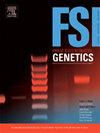Non-destructive identification of forensically relevant body fluid stains using a portable electronic nose: A pilot study
IF 3.1
2区 医学
Q2 GENETICS & HEREDITY
引用次数: 0
Abstract
Identification of bodily fluid stains is crucial for forensic investigations. While current molecular detection methods provide high accuracy, their destructive sampling nature imposes significant limitations on trace samples by compromising sample integrity and subsequent short tandem repeat (STR) profiling. To date, no non-destructive method for fluid identification has been reported. This study introduces a novel portable electronic nose (e-nose) technology that facilitates non-invasive differentiation through the detection of volatile organic compounds (VOCs) in bodily fluids. Requiring only 3–4 min per test while preserving DNA integrity, this approach effectively distinguishes morphologically similar fluids such as blood and menstrual blood, offering an innovative solution for the non-destructive analysis of forensic body fluid. In this study, VOCs from 200 body fluid samples—including blood, saliva, semen, vaginal secretions (VS), and menstrual blood (MB)—were analyzed using electronic nose technology. Samples were collected via sterile swabs (n = 100) and toilet paper (n = 75). Radar plots indicated that sensor S7 (W1W) exhibited peak responses across both carriers. Linear discriminant analysis of the 175 samples revealed distinct clustering patterns (ANOSIM R = 0.088, p < 0.001). The random forest-based predictive models demonstrated that the general model—non-carrier-specific with n = 175—achieved accuracies of 100.00 % for VS, 90.91 % for blood, 81.82 % for semen, 72.73 % for MB, and 63.64 % for saliva; resulting in an overall accuracy of 81.82 %. Notably, when specifically utilizing toilet paper as a carrier, accuracy improved to 92.00 %, with saliva, MB, and VS achieving perfect scores at 100.00 %, while blood and semen reached accuracies of 80.00 %. An external validation set comprising n = 25 was employed to assess accuracy using sterile swab carriers; results indicated an overall accuracy rate of 84.00 %. Specifically: both blood and saliva achieved perfect scores at 100.00 %, whereas semen and MB recorded accuracies of 80.00 %. Conversely, the lowest accuracy was observed for VS at 60.00 %. This study marks the first use of a portable e-nose to differentiate common body fluids, offering a promising, low-cost, non-destructive and user-friendly approach for forensic analysis.
使用便携式电子鼻对法医相关体液污渍进行无损鉴定:一项试点研究
鉴定体液污渍对法医调查至关重要。虽然目前的分子检测方法提供了很高的准确性,但它们的破坏性采样性质通过损害样品完整性和随后的短串联重复(STR)分析,对痕量样品施加了显著的限制。迄今为止,尚无无损流体识别方法的报道。本研究介绍了一种新型便携式电子鼻(e-nose)技术,该技术通过检测体液中的挥发性有机化合物(VOCs)来促进非侵入性区分。每次检测只需要3-4 分钟,同时保持DNA的完整性,这种方法有效地区分了形态相似的液体,如血液和经血,为法医体液的非破坏性分析提供了创新的解决方案。在这项研究中,使用电子鼻技术分析了来自200个体液样本的挥发性有机化合物,包括血液,唾液,精液,阴道分泌物(VS)和经血(MB)。通过无菌拭子(n = 100)和卫生纸(n = 75)采集样本。雷达图显示,传感器S7 (W1W)在两个载波上都表现出峰值响应。175个样本的线性判别分析显示出不同的聚类模式(ANOSIM R = 0.088, p <; 0.001)。基于随机森林的预测模型表明,一般模型(n = 175)对VS、血液、精液、MB和唾液的准确率分别为100.00 %、90.91 %、81.82 %、72.73 %和63.64 %;总体精度为81.82 %。值得注意的是,当专门使用卫生纸作为载体时,准确性提高到92.00 %,唾液,MB和VS达到100.00 %的完美分数,而血液和精液的准确性达到80.00 %。采用外部验证集n = 25来评估无菌拭子载体的准确性;结果表明,总体准确率为84.00 %。具体来说:血液和唾液都达到了100% %的完美分数,而精液和MB记录的准确性为80.00 %。相反,VS的最低准确率为60.00 %。这项研究标志着首次使用便携式电子鼻来区分常见的体液,为法医分析提供了一种有前途的、低成本的、非破坏性的和用户友好的方法。
本文章由计算机程序翻译,如有差异,请以英文原文为准。
求助全文
约1分钟内获得全文
求助全文
来源期刊
CiteScore
7.50
自引率
32.30%
发文量
132
审稿时长
11.3 weeks
期刊介绍:
Forensic Science International: Genetics is the premier journal in the field of Forensic Genetics. This branch of Forensic Science can be defined as the application of genetics to human and non-human material (in the sense of a science with the purpose of studying inherited characteristics for the analysis of inter- and intra-specific variations in populations) for the resolution of legal conflicts.
The scope of the journal includes:
Forensic applications of human polymorphism.
Testing of paternity and other family relationships, immigration cases, typing of biological stains and tissues from criminal casework, identification of human remains by DNA testing methodologies.
Description of human polymorphisms of forensic interest, with special interest in DNA polymorphisms.
Autosomal DNA polymorphisms, mini- and microsatellites (or short tandem repeats, STRs), single nucleotide polymorphisms (SNPs), X and Y chromosome polymorphisms, mtDNA polymorphisms, and any other type of DNA variation with potential forensic applications.
Non-human DNA polymorphisms for crime scene investigation.
Population genetics of human polymorphisms of forensic interest.
Population data, especially from DNA polymorphisms of interest for the solution of forensic problems.
DNA typing methodologies and strategies.
Biostatistical methods in forensic genetics.
Evaluation of DNA evidence in forensic problems (such as paternity or immigration cases, criminal casework, identification), classical and new statistical approaches.
Standards in forensic genetics.
Recommendations of regulatory bodies concerning methods, markers, interpretation or strategies or proposals for procedural or technical standards.
Quality control.
Quality control and quality assurance strategies, proficiency testing for DNA typing methodologies.
Criminal DNA databases.
Technical, legal and statistical issues.
General ethical and legal issues related to forensic genetics.

 求助内容:
求助内容: 应助结果提醒方式:
应助结果提醒方式:


